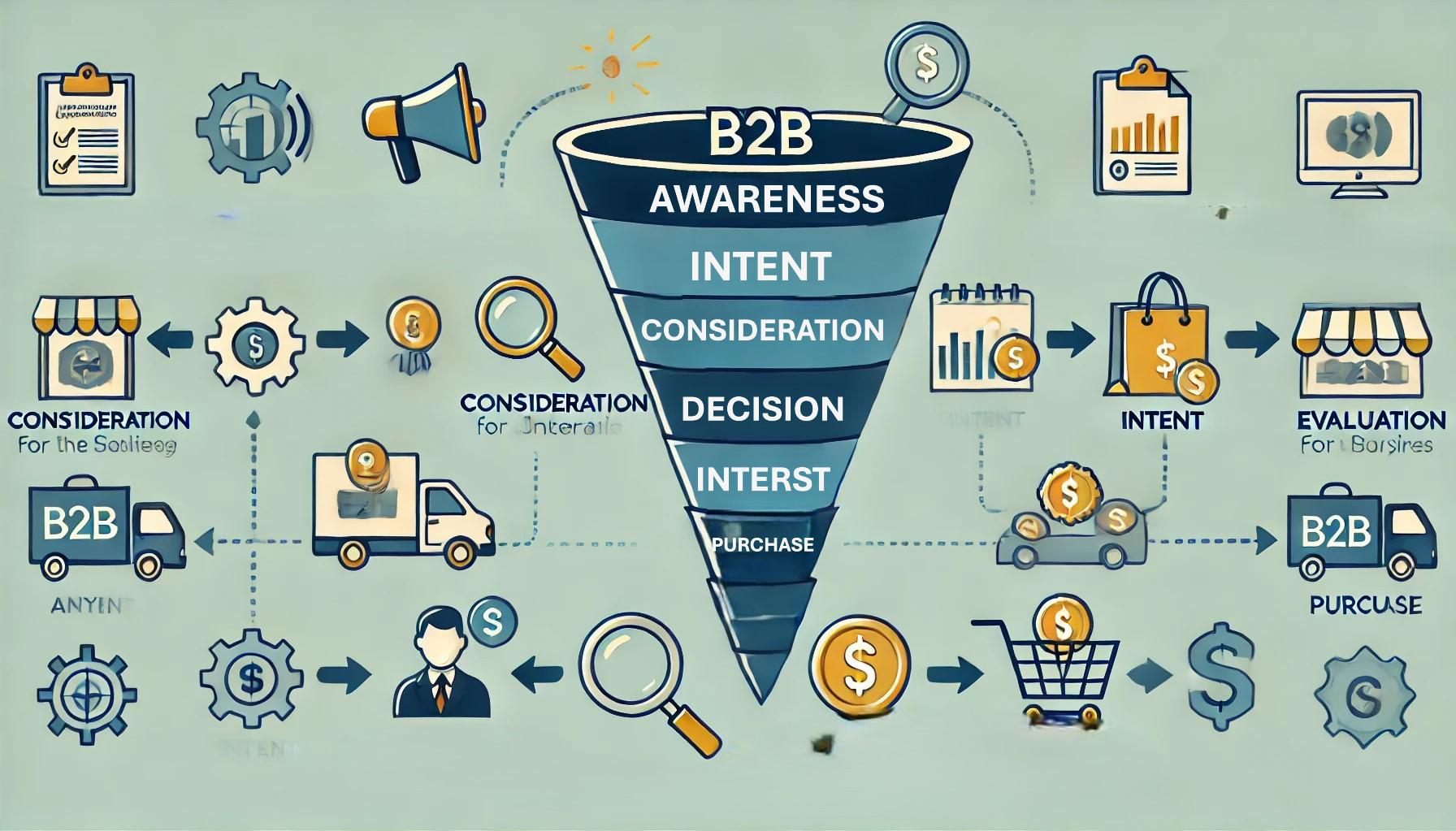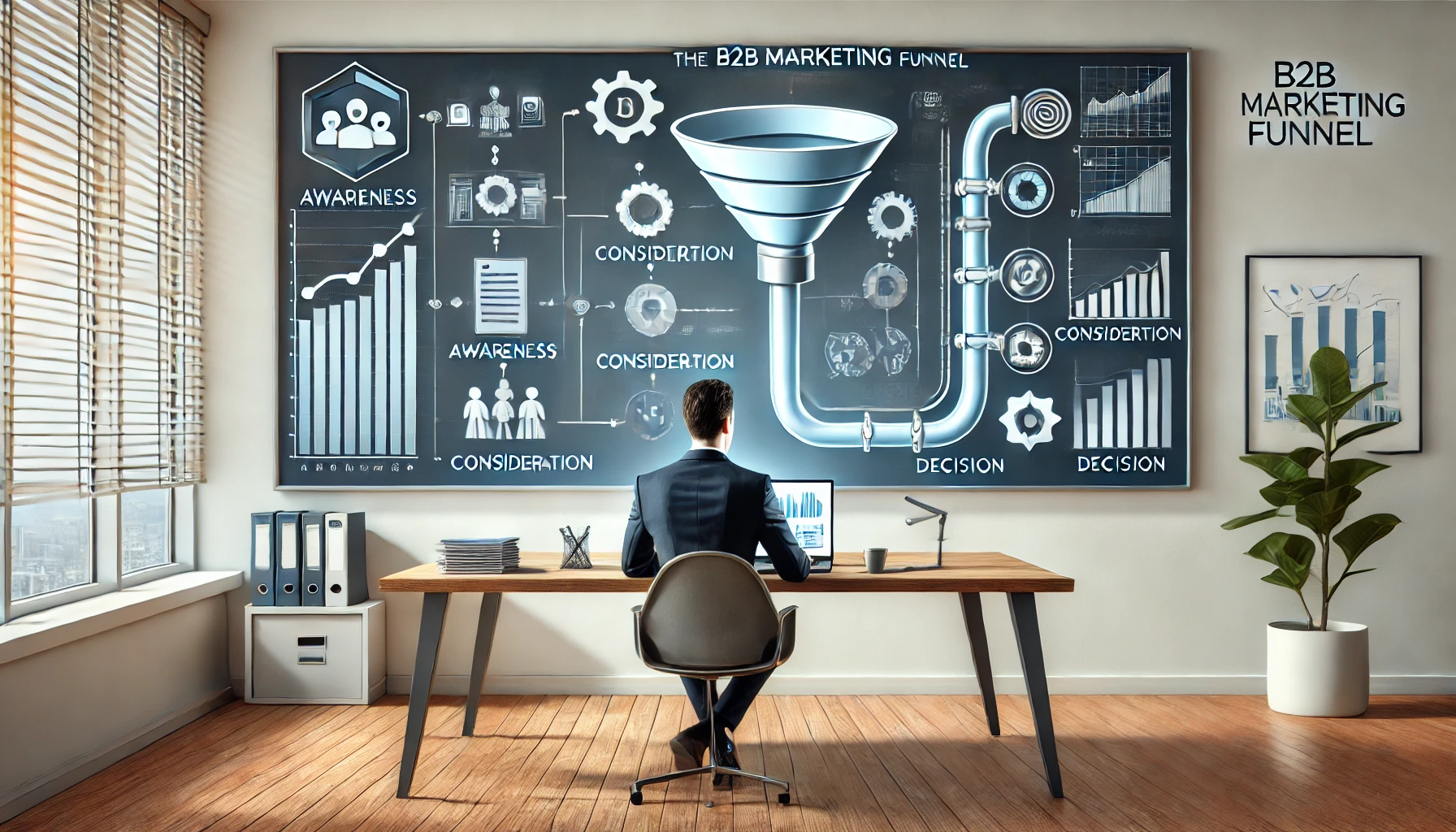Introduction to the Concept of B2B Marketing Funnel
When it comes to building strong B2B connections, understanding the B2B marketing funnel is essential.Each of these steps in the funnel is geared towards transforming potential consumers into consumers as well as to ensure that they are creating trust with these consumers in the process. With a good funnel, one can set to convert the interested leads into customers who will be of value to the firm in future. In this piece, we are going to take you through the B2B marketing funnel stages, as well as the best practices and practical tips that can be useful for B2B businesses to improve their leads generation and conversion.
also read: B2B Marketing Strategy Guide

What does B2B Marketing Funnel mean?
The B2B marketing funnel is a model that outlines the steps that a particular prospect takes in a particular marketing process right from the moment they gain awareness that the business exists up to the point when they purchase a product. Unlike the B2C consumers, B2B funnels include multiple users, a longer buying cycle, and several steps to make a purchase. Every level of the sales funnel is otherwise crucial in ensuring that the prospects gain the necessary inclination to make a purchase at the appropriate stage in the process.
B2B Marketing Funnel Model
Why It’s Important to Understand the Funnel
Understanding the dynamics of B2B marketing funnels is always helpful to a business in terms of its success. Leads are not just generated for B2B organizations but are developed over time and need to be taught when to buy. With knowledge of what each stage in the funnel entails, organisations can come up with materials and plans that directly address their target market’s needs at every given level. It is trustful since it does not sell the organisation merely as a supplier, but as an ally.
Stages in the B2B Marketing Funnel
The B2B marketing funnel can be broken down into three key stages:
- Awareness
- Consideration
- Decision
But the strategies, objectives, and even the outcomes vary from one stage to the other. The following are a detailed description of each stage and how it help in persuading the leads towards a purchase decision.
Awareness Stage:
- Attracting Potential Leads: Awareness stage is all about generating leads and bringing them to knowledge of the existence of your business. By this stage, the concern is neither about the direct marketing of products but about leads identifying your company and solutions.
- Identifying Your Target Audience: To need to specify the target customers is the first step to creating the ideal customer avatar. Developing buyer persona, a description of the type of customer that you want to attract can assist to position the strategies in the right form. Some of these may include industry type, size of the organization, problem solving or arriving at strategic objectives.
- Crafting Engaging Content: Content in the Awareness stage should be educational, informative, and designed to spark interest. Blog posts, videos, infographics, and case studies work well here. Address common problems your target audience faces and offer insights to establish your brand as a helpful resource.
- Utilizing SEO, Social Media, and Paid Ads: This is important in making your content easily found. This way it is essential to use the terms such as ‘B2B marketing funnel’ in order to enhance the visibility on the resource. Coupled with this is the use of the social media and special announcements to reach a broader market. LinkedIn for instance is more favorable to B2B companies because it is a professional oriented platform.
Consideration Stage:
- Nurturing Leads: Leads that are in the Consideration stage are those who know your company exists, but they have not engaged themselves enough. Here, your role is to help the leads to grow by providing more information in terms of value.
- Lead Magnets and Content Offers: Offer newsletters, informative eBooks, white papers or webinars and offer great content in exchange for their contact details. Such resources should provide answers to questions, solve problems, or explore subjects of concern to your leads.
- Email Marketing Strategies: Email is not yet outmoded when it comes to lead nurturing. Create a drip campaign—a sequence of messages sent by email—and disseminate valuable information, positioning your brand. These emails should be customized according to the trimming of the lead interested or the way he/she has behaved.
- Retargeting and Remarketing Tactics: It is sometimes necessary to remind leads. Social media or search engine ads retargeting might be of assistance here. This is the case because by displaying the ads to the leads who have visited your site, you are likely to have them come back down the funnel.
Decision Stage:
- Converting Leads to Customers:Decision stage leads are those that are almost ready to buy a product in that they are close to making a decision. It is here that your objective now turns to calming and directing them to make that conversion.
- Building Trust with Case Studies and Testimonials: Decision stage leaders often require affirmation. A word from satisfied clients and real-life examples make your solution believable and believable to other clients.
- Personalized Proposals and Offers: The best way to show that you have listened to the needs of each lead is by addressing them individually to show that you know what they are going through. In particular, a subject-specific proposal, product presentation or consultation can greatly impact the buying decision.
- Effective Calls to Action (CTAs): Conversion-centric CTAs that call the customer to action, e.g., Request a Demo, Free Trial, or download, are useful. Ensure that all Call To Actions are well written and noticeable on your webpage.
Effective tools and Optimal Strategies for the Management of a Funnel
B2B marketing funnel management is a intricate process, but it is very possible to optimize it.
- Marketing Automation Tools: Tools like HubSpot or Marketo or Pardot allow to automate everything from email follow-up sequences to lead scoring so that one does not lose the ability to personalize when dealing with high numbers of leads.
- CRM Integration: A system such as Salesforce or Zoho is a CRM – Customer Relationship Management which entails all the leads, interactions, and progress through the funnel. CRM integration can also monitor what you are doing with customers on different platforms and how you can transfer clients from one channel to another.
- Lead Scoring and Tracking: Lead scoring is a way to categorise leads depending on their prospects to purchase. When scoring based on the actions taken such as visiting the webinar registration page, or the pricing page, it is possible to differentiate between good leads that need follow up.
Key Metrics to Measure Funnel Success
It’s also important to understand the specific metrics used to track funnel success as well as additional measures to evaluate the funnels’ performance.
Evaluation of the performance indicators that should be adopted in a company involves tracking the performance at each stage of the funnel.
- Click-Through Rate (CTR), Conversion Rate, and Engagement Rate: They show how interested your leads are in the content you create and share. Consequently, those brands or websites that have low CTRs might require improved headlines, whereas, low conversion rates might mean that the CTAs need improvement.
- Lead Qualification (MQL, SQL): Marketing Qualified Leads (MQLs) and Sales Qualified Leads (SQLs) are measures that help to distinguish visitors from real customers. MQLs indicate interest, whereas SQLs need to be filtered for sales communication.
- Analytics for Optimization: Free sources such as Google Analytics to be utilized to determine areas in the funnel that are leading to slow down or stagnation of the process. For instance if the leads are slipping through in the Consideration stage, then possibly the content needed here is more compelling or the follow-up game plan could be much tighter.
Overcoming Common Funnel Challenges
Addressing Seven Key Funnel Issues: There are certain workflows that are unique to B2B marketing funnels, but such issues are preventable.
- Low Conversion Rates in the Awareness Stage: The worst thing that can happen to a site is that it garners attention only to wane after a short while of reduced engagement. Providing tools with the aim of creating awareness through offering of guides and explainer videos assist in creating trust and increased conversion rates.
- Lead Quality vs. Quantity: One of the popular challenges is the tension between quality and quantity. Instead of concentrating on the quantity of leads you get, aim at the quality of the leads. This could be achieved using advertisement and content that is niche-specific addressing a particular pain point and belonging to a particular industry.
- Managing the Long Sales Cycle: It takes a lot of time and hard work to build relationships in B2B selling because the sales cycle is usually long. The leads are not fully lost since they are engaged all through the loop with updates, check-ins, and valuable content
Recommendations of Strategies to be Adopted in the Management of the Funnel
Creating a proper B2B funnel is not going to happen in one day. Here are some best practices to keep in mind:
- Continuous Testing and Refinement: When creating email content, use A/B testing to determine which headlines and CTAs are effective for reaching the target audience. Although it’s good to experiment, testing often reveals what your audience finds most engaging.
- Personalization Across Channels: Overwrite your messages in all the touchpoints—Be it through email, social media, or even your website. With personalized content, the amount of engagement is always higher and the conversion time always shorter.
- Alignment Between Marketing and Sales Teams: Marketing and sales often report to different managers and hence end up missing out on some opportunities. Improved meeting with shared objectives help in providing better handover and better funnel results..
Conclusion
B2B marketing funnel is a tool that requires time, efforts, and a proper understanding of each stage of the process from the buyer’s perspective. In this way, businesses can build a funnel that actually turns leads into customers: By focusing on the Awareness, Consideration and Decision stage, using the right tools and adjusting these strategies all the time. By practicing these tactics, you will be well on your way to achieving the longevity that your business so desperately needs.
FAQs
-
What’s the purpose of the B2B marketing funnel?
The B2B marketing funnel helps guide prospects through each stage, from discovering your business to making a purchase. It ensures leads are nurtured and converted effectively at every stage.
-
What are MQLs and SQLs?
MQLs (Marketing Qualified Leads) are leads deemed likely to become customers based on their engagement. SQLs (Sales Qualified Leads) are those ready for direct sales contact after further qualification.
-
How can personalization improve my B2B marketing funnel?
Personalized content helps increase engagement by catering to the unique needs of each lead. It can significantly speed up conversions by addressing specific challenges and goals.
-
Why is the Awareness stage crucial?
The Awareness stage is the first interaction point where prospects discover your brand, setting the foundation for further engagement. It is key for generating interest and attracting quality leads.
-
What tools are essential for B2B funnel management?
Essential tools for managing the B2B marketing funnel include CRMs, marketing automation platforms, and analytics tools. These tools help track leads, automate processes, and optimize funnel performance.
-
How do you move leads through the B2B marketing funnel effectively?
You can move leads effectively by providing valuable, targeted content and using email nurturing strategies. Personalize your communication based on lead behavior and interests.
-
What role does content marketing play in the B2B marketing funnel?
Content marketing is essential in building trust, educating prospects, and providing valuable resources at each funnel stage. It helps engage leads and move them closer to conversion.
-
How can I measure the success of my B2B marketing funnel?
You can measure success using key performance indicators (KPIs) like conversion rates, lead qualification (MQLs, SQLs), and engagement metrics. These metrics help you evaluate how well leads are progressing through the funnel.
-
What are common mistakes in managing a B2B marketing funnel?
Common mistakes include failing to segment leads effectively, not personalizing content, or neglecting the nurturing process. These can lead to low conversions and missed opportunities.
-
How long does it take to optimize a B2B marketing funnel?
Optimizing a B2B marketing funnel is an ongoing process that can take several months. It involves constant testing, data analysis, and fine-tuning strategies to improve results over time.



